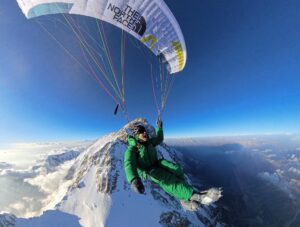We’ve followed the career of Francesco Ratti on expeditions to Tengkampoche in Nepal (2021) and Uli Biaho Spire (2022), plus several remarkable climbs in his home range, the Italian Alps.
Now, after working all summer as a professional mountain guide in Aosta, Ratti is filling his bag for a new expedition. This time, he has chosen the Miyar Valley, in Himachal Pradesh.
In a pre-departure chat with ExplorersWeb, Ratti shared thoughts and expectations about the trip. Instead of thinking of a highly technical line or a record, Ratti has the attitude of a traveler, looking forward to seeing something new and enjoying a holiday climbing with good friends.
Into the wild
“When I plan expeditions, I look for wilder areas, less visited, and with good options for new routes. In that sense, Miyar Valley is perfect. Besides, it is great because it will be my first time in India and I can’t wait to see some of the country, meet its people, feel the place!”

The Neverseen Tower in Miyar Valley. Photo: Francesco Ratti Press Team
The team made a preliminary plan to go and look for a suitable line on either the Neverseen Tower (5,800m) or Mahindra Peak (6,080m). Climbers have summited both, so my first question was: why not go for a first ascent? “It’s because the Neverseen Tower and Mahindra were the peaks we like the most,” Ratti said. “It is okay that they’ve been climbed before, we are sure there are still great lines to open.”
Ratti emphasized that they will look for logical, aesthetic lines. “Difficulty will come after, when we get on the route. But what really attracts us is discovering lines that are crying out to be opened.”
Then, the state of the granite and the approach on the glacier will have the last word. “If we see the rock is not in good condition, we’ll look for something else. We really like that altitude, close to 6,000m, but going to some lesser peak is not a problem either.”

Ratti ice-climbing. Photo: Francesco Ratti Press Team
Better with friends
The rest of Ratti’s team share the same mentality. “We have never climbed all together as a four-person team, but we know each other and have climbed together on numerous occasions,” Ratti said. “When you’re going to spend a month in solitude, you’d better get along well with your expedition friends. You need to trust in your climbing partners because things can go south in the mountains.”
Ratti climbed with Alessandro Bau on Uli Biaho and in Patagonia last season; Jerome Perruquet was in the Tengkampoche team and the two of them climb near Aosta regularly.
“Lorenzo [D’Addario] is a long-time friend from the Dolomites, we did the guiding course together. Then we lost track of each other for a time because he had to stop [climbing] for a while to recover from an accident, but we know him well.”
The idea of traveling to India was originally cooked up by Ratti and D’Addario. After, they roped in their regular climbing mates.
The 8,000’ers, lights and shadows
We asked Ratti whether he had considered trying the 8,000ers, and he shared an interesting point of view. “I was once on Manaslu, which was a valid experience as an encounter with that altitude and to see how my body responded to the climb without O2. But it is not an experience I would repeat. I don’t like the crowded Base Camps and long lines on the ropes,” he said.
“However, I am not one to criticize the commercial expeditions, there are a lot of people living from them and improving their lives thanks to the business. It is a complex issue with no easy solution. In addition, the local communities, the people working on the mountains, and the companies, are all becoming more aware of the situation and making efforts…to raise attention toward garbage management and try to improve the situation.”

Francesco Ratti deals with ropes while climbing in the Alps, where he works as a mountain guide. Photo: Francesco Ratti Press Team
As a professional guide in the Alps, Ratti is used to crowded mountains. “The main difference is that there is no tented Base Camp, but in places such as Mont Blanc or the Matterhorn, especially in July and August, there are so many people, the mountain huts are fully booked…but it means work for us guides. It is a good thing to lead people up to peaks that we have been to hundreds of times, for them it is a fulfilled dream and a chance to be in a mountain environment that they are not familiar with and therefore find so impressive,” Ratti explained.
“On the other hand, it is not surprising that when I go on an expedition, I want to live a completely different experience, in wilder, lonelier mountains,” he said. On an 8,000’er, that would mean looking for different routes or off-season climbs.
Off-season climbs are difficult for a climber with limited time but Ratti would consider alternative routes. “Of course, at such altitude, the technical level of the climb needs to be lower than at 6,000m, one must look for that balance between extreme altitude and technical difficulty but, if I find a good option in the future, why not?”






